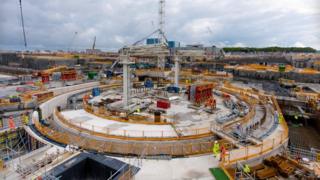
UK clinches deal to boost offshore wind
 Image copyright PA
Image copyright PA A deal confirmed between the UK government and the wind industry will ensure 30% of electricity comes from offshore wind by 2030.
The move will help the UK towards an aim of securing almost all its power from low-carbon sources by 2030.
It is the latest in a series of agreements with sectors of the economy that are likely to create jobs.
But environmentalists are wondering where the other 70% of the UK’s clean electricity will come from.
That is because, for several years, government economists have foreseen a three-pronged energy policy by 2030.
First power from world’s biggest wind farm
So what are the future energy sources?
Civil servants have projected that 30% of electricity would come from offshore wind, 30% from nuclear and 30% from gas power stations fitted with technology to capture their carbon emissions and bury them.
But here is the reality – it is now confirmed that wind will fulfil its part by 2030.
But plans to expand nuclear are foundering; indeed the UK may end up at worst with just one new nuclear station – at Hinkley – instead of the planned six.
As for gas with carbon capture, there is only a single such power plant planned at commercial scale. And that is stuck in the proposal stage.
The government promises it will meet pledges to keep the lights on and cut emissions.
Its commitment is for offshore wind to produce 30 gigawatts (GW) by 2030, creating thousands of so-called “green collar” jobs in the process. Young people are especially attracted to jobs in the environment sector.
But green groups believe much more is needed – probably half as much again (45GW).
What do environmentalists say?
 Image copyright EDF
Image copyright EDF John Sauven, executive director of Greenpeace UK, said: “Now the government’s plans for a fleet of new nuclear reactors has collapsed, it leaves Britain with a big energy gap in future.
“It means the latest offshore wind target of 30GW by 2030 is woefully inadequate.
“Wind and solar must be tripled between now and 2030, with offshore wind the future backbone of the UK’s energy system.”
Rachel Reeves, chair of the Commons business, energy and industrial strategy (BEIS) committee said: “Investment decisions over nuclear plants such as Moorside and Wylfa have left the UK facing a giant hole in its energy policy.
“Given that dirty coal is due to go off-line, and the prospects for nuclear looking uncertain, it’s vital the government comes forward with a Plan B to plug the energy gap.”
Are there alternatives?
Some analysts are more relaxed. Richard Black from the think-tank Energy and Climate Intelligence Unit (ECIU) thinks three new nuclear plants are likely – and he believes the market will sort out the 2030 problem.
He told BBC News: “Delivery of new nuclear stations at Hinkley, Sizewell and Bradwell, which looks likely, would provide about 20% of electricity demand.
“Gas will be providing about 15%, and there’ll be a bit of biomass on the system too.
“As for the rest – new onshore wind needs no subsidy, and offshore wind and solar are at the tipping point of being subsidy-free. So it’s reasonable to expect all three to be built through the open market.”
Follow Roger on Twitter.
Read more: https://www.bbc.co.uk/news/science-environment-47476006

Leave a Reply